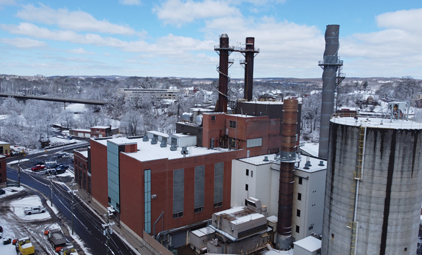City of Jamestown
Chautauqua County

A Public Utility Discovers Strengths, Vulnerabilities with a NYSERDA Just Transition Site Reuse Planning Study
The Board of Public Utilities’ Samuel A. Carlson Electric Generating Station is one of the oldest municipal power plants in the country. The City of Jamestown’s BPU (JBPU) is the largest of 47 municipally-owned-and-operated utilities with generation in New York State.
JBPU first began generating electricity in 1891. Since then, it has evolved into a municipal utility provider and a core part of the community.
Jamestown Utilities: The Back Story
The plant’s capacity and ways of generating power have changed over time. In 1948, with the advent of district heating, JBPU established its first district heating system, which ran on steam. This system was ultimately abandoned in 1969 as customers switched to lower cost natural-gas-fired equipment.
The community’s second (and current) district heating system was installed in 1984 and -- as the first hot water district heating system in New York State -- used an innovative system of cogeneration with 240°F hot water. Cogeneration, or combined heat and power, uses waste heat from the production of electricity and produces both heat and electricity from a single source.
Jamestown Board of Public Utilities' Samuel A. Carlson Generating 

Plant.
Snapshot
Population: 28,000 (Includes City of Jamestown, the Village of Falconer, and the Town of Ellicott)
Plant: Jamestown Board of Public Utilities District Heating System
Energy profile: District heating, which includes natural gas generation and boilers; hot water; and cogeneration
Study timeline: December 2022 - December 2024
This system supplies 68 customers with space heating and domestic hot water. Some buildings in the network, which include an ice rink and hospital, have additional loads.
As of 2024, however, 85% of the network’s direct-buried piping system (which has been in operation for 40 years) has reached end of life. Additionally, some customers have left the district heating network to install their own local gas-fired boilers. The plant and the community now face two challenges: the high capital cost of replacement and the competitive price of natural gas.
Facing these challenges and needing more information before deciding on the community’s energy future, JBPU applied to NYSERDA’s Just Transition Site Reuse Planning Program for a planning study. The program provides communities with planning services to inform future decision making, which helps them mitigate any negative impacts of pending or potential future fossil fuel power plant closures.
Additionally, the study is conducted at no cost to municipalities and helps the local communities to align with the State’s Climate Act goals.
"The district heating system was innovative when it was installed in the 1980s and has served the community well. But, with the change in economic conditions, the increasing age of the system, and New York State’s decarbonization plans, the JBPU staff were looking for resources to assist us in evaluating the future of the district heating system."
-Kristofor G. Sellstrom, BPU Transmission and Distribution Manager
Applying for a Study, Announcing Results
JBPU’s status as a municipal utility provider enabled it to apply to the NYSERDA program. (All municipalities are eligible to apply, not just municipal utility providers.) Its first priority was finding a solution for the heat it provided to the community.
JBPU announced the award to the community through its newsletters. The City also communicated it to some of its larger customers that would be visited as part of the study.
At the conclusion of the study, JBPU held multiple, in-person stakeholder engagement meetings with customers, plumbing and electrical contractors, and community members to review the results, gather additional feedback, and communicate JBPU’s plan to move forward.
What the Study Revealed
"As Jamestown continues its journey of pursuing sustainable, low cost, and creative solutions for our residents and customers, we look forward to strengthening our relationship with NYSERDA and other State and federal agencies, to help our community move forward to an era of clean, reliable, and affordable energy. We hope that our journey can be replicated by others across the state and county. "
-Kristofor G. Sellstrom, BPU Transmission and Distribution Manager
The study helped the City of Jamestown evaluate a variety of options and pathways to solve their heating needs. Some of the points the study uncovered included:
- It narrowed down the possible paths forward for reuse and determined that wastewater effluent heat recovery is the most viable low-carbon solution for the communities’ long-term needs.
- Any new solution will cost the community significantly more, but it helped quantify that increase as well as showcase the fully embedded costs of the lower cost natural gas alternatives and helped narrow in on size of the funding gap.
- Existing customers face risk due to the age of their building systems and most will need to find an innovative approach going forward, which is a challenge because of Jamestown’s status as a historically underserved community.
- A new system has the potential to double the system size and create opportunities for local industrial customers to participate and decarbonize their facilities to help keep them competitive from a carbon emissions perspective.
- An 85% reduction target for thermal energy is technically possible, but affordable emission free-peaking technologies are still needed to fully decarbonize. Focusing on 85% today is a significant improvement and if built as a centralized system, the remaining emissions could be later fully eliminated when lower cost peaking technologies come to market.
- De-coupling thermal energy needs from the electrical peaks leveraging thermal storage may be an important system attribute and a low-cost option to reduce energy demand volatility and energy market risk.
Comments from JBPU
The detailed engineering study has helped narrow in on the direction and scope of the significant project challenges ahead for our community to meet its heating needs while reducing carbon emissions, increasing community resiliency, and maintaining low-cost rates for our residents, business, and industry.
